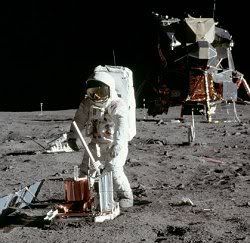First there were earthquakes. Then there were sunquakes. Now it seems as if Earth’s little sister may have caught “the shakes” which could threaten future lunar settlements.
(NASA) There are at least four different kinds of moonquakes: (1) deep moonquakes about 700 km below the surface, probably caused by tides; (2) vibrations from the impact of meteorites; (3) thermal quakes caused by the expansion of the frigid crust when first illuminated by the morning sun after two weeks of deep-freeze lunar night; and (4) shallow moonquakes only 20 or 30 kilometers below the surface.
The first three were generally mild and harmless. Shallow moonquakes on the other hand were doozies. Between 1972 and 1977, the Apollo seismic network saw twenty-eight of them; a few “registered up to 5.5 on the Richter scale,” says Neal. A magnitude 5 quake on Earth is energetic enough to move heavy furniture and crack plaster.
Furthermore, shallow moonquakes lasted a remarkably long time. Once they got going, all continued more than 10 minutes. “The moon was ringing like a bell,” Neal says.
According to NASA, because the Moon (aka Luna) lacks water and an atmosphere to soften the ground below, whenever a lunar quake occurs the whole ground just keeps “vibrating like a tuning fork.”
While more data is needed whether to determine how often (and exactly where) do luner quakes occur upon Earth’s nearest neighbor, and future settlement established there will probably have to design very flexible outposts (in order to prevent life threatening cracks from appearing in the walls).

